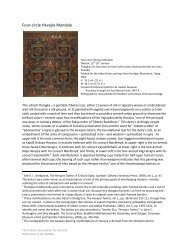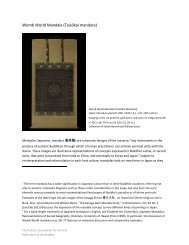Reflections of the Buddha - The Pulitzer Foundation for the Arts
Reflections of the Buddha - The Pulitzer Foundation for the Arts
Reflections of the Buddha - The Pulitzer Foundation for the Arts
Create successful ePaper yourself
Turn your PDF publications into a flip-book with our unique Google optimized e-Paper software.
View <strong>of</strong> <strong>the</strong> Main Gallery<br />
<strong>The</strong>se heavily gilded works look all <strong>the</strong> more ornate in<br />
<strong>the</strong> austerity <strong>of</strong> Andō’s spaces, while <strong>the</strong> space around<br />
<strong>the</strong>m becomes more dynamic.<br />
<strong>The</strong> <strong>Pulitzer</strong>’s presentation <strong>of</strong> Buddhist art<br />
allows <strong>the</strong> visitor to see each work from several unobstructed<br />
viewpoints and it silhouettes <strong>the</strong> sculptures,<br />
<strong>of</strong>fering <strong>the</strong>m additional visual power and energy. <strong>The</strong>se<br />
Buddhist sculptures likely have never had <strong>the</strong> luxury <strong>of</strong><br />
so much space — nei<strong>the</strong>r in <strong>the</strong>ir original sites nor in<br />
some <strong>of</strong> <strong>the</strong>ir new repositories, including <strong>the</strong> <strong>of</strong>ten<br />
crowded galleries <strong>of</strong> encyclopedic museums. <strong>The</strong> placement<br />
<strong>of</strong> <strong>the</strong>se works in Andō’s architecture gives <strong>the</strong><br />
viewer <strong>the</strong> freedom to appreciate <strong>the</strong>se works in an expanded<br />
way. This approach is partially Minimalist. An<br />
American museum director in <strong>the</strong> 1980s once spoke <strong>of</strong><br />
“<strong>the</strong> synchronic museum” that <strong>for</strong>egoes history in <strong>the</strong><br />
name <strong>of</strong> “a kind <strong>of</strong> intensity <strong>of</strong> experience, an aes<strong>the</strong>tic<br />
charge that is not so much temporal (historical) as it is<br />
now radically spatial . . . It is Minimalism . . . that has reshaped<br />
<strong>the</strong> way we, as late twentieth-century viewers,<br />
look at art: <strong>the</strong> demands we now put on it; our need to<br />
experience it along with its interaction with <strong>the</strong> space in<br />
which it exists.” 22<br />
<strong>The</strong> dominant Asian influences in <strong>the</strong> United<br />
States <strong>for</strong> much <strong>of</strong> <strong>the</strong> twentieth century were Japanese<br />
art and Zen Buddhism. In <strong>the</strong> 1950s and 1960s, <strong>the</strong>y inspired<br />
Western Minimalist artists with <strong>the</strong> principles <strong>of</strong><br />
simplicity and understatement. In <strong>the</strong> 1970s, Western<br />
Minimalism in turn in<strong>for</strong>med contemporary Japanese architects<br />
like Andō, with its systematic thinking<br />
characterized by repetition and progressions <strong>of</strong> <strong>for</strong>ms. In<br />
a recent book about his own processes and ideas, Andō<br />
13<br />
spoke about <strong>the</strong> <strong>Pulitzer</strong>’s architecture in Minimalist<br />
terms: “[W]ith <strong>the</strong> simplest possible <strong>for</strong>m, [<strong>the</strong> <strong>Pulitzer</strong>]<br />
was composed as <strong>the</strong> ultimate box.” 23 It is “embedded<br />
with a grid space based on an identical module in plan<br />
and section.” 24<br />
<strong>The</strong> use <strong>of</strong> repetitive <strong>for</strong>ms plays a role in <strong>the</strong><br />
display <strong>of</strong> art in <strong>Reflections</strong> <strong>of</strong> <strong>the</strong> <strong>Buddha</strong> as well. For instance,<br />
four-circle mandalas <strong>of</strong> <strong>the</strong> Sakya School <strong>of</strong><br />
Tibetan Buddhism (nos. 11-12) are displayed in <strong>the</strong><br />
<strong>Pulitzer</strong>’s eponymous Cube Gallery. <strong>The</strong>se hierarchical<br />
and geometric diagrams <strong>of</strong> Buddhist cosmology were<br />
likely guides <strong>for</strong> meditation rituals. Based on <strong>the</strong> Hevajra<br />
Tantra (a Vajrayāna text written sometime between <strong>the</strong><br />
late eighth and early tenth centuries), <strong>the</strong> Sakya School’s<br />
teachings <strong>of</strong>fer a practitioner a particular way to understand<br />
a key concept found in both Mahāyāna and<br />
Vajrayāna Buddhism: Nirvāna already exists in samsāra.<br />
<strong>The</strong> defilements <strong>of</strong> samsāra simply cover this pure knowledge<br />
from view. Each Sakya mandala in <strong>the</strong> Cube Gallery<br />
depicts four circles symmetrically aligned. Each circle<br />
represents an architectural plan <strong>of</strong> a palace with walls<br />
and gateways at <strong>the</strong> cardinal directions. Inside each circle<br />
is a square; inside <strong>the</strong> square is a circle. <strong>The</strong> symmetry <strong>of</strong>fers<br />
a sense <strong>of</strong> order and permanence found in a<br />
particular deity’s celestial realm. This is <strong>the</strong> palace that<br />
<strong>the</strong> practitioner visualizes as <strong>the</strong> home <strong>for</strong> <strong>the</strong> deity. As<br />
one scholar has noted, <strong>the</strong> deity is like “a germinating<br />
seed [that] is within, and protected by, its outer shell.” 25<br />
It is here where <strong>the</strong> teacher (lama) helps <strong>the</strong> initiate connect<br />
with <strong>the</strong> deity and understand that impermanence<br />
and dukha can be “extinguished” in one’s own lifetime.<br />
Andō, too, chooses repetitive <strong>for</strong>ms — simple




